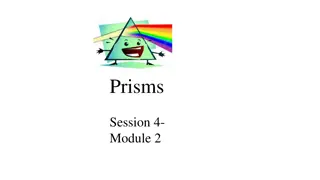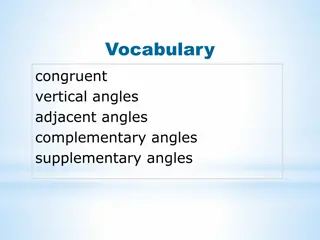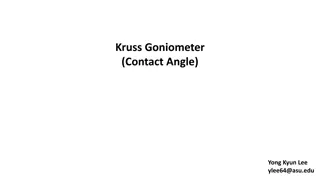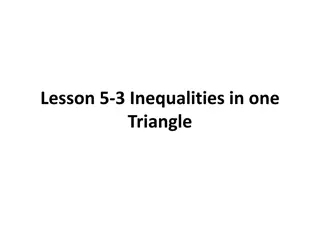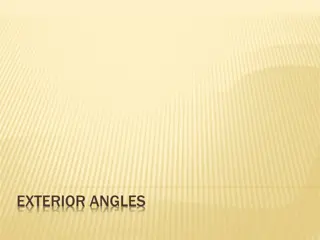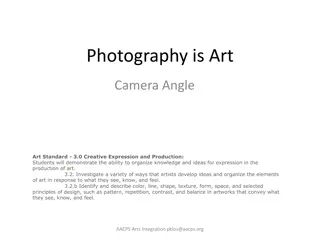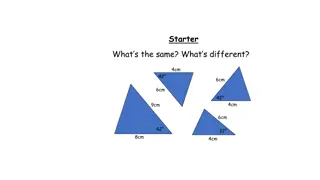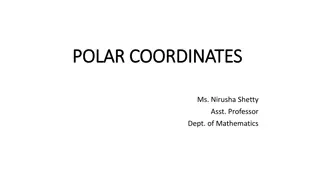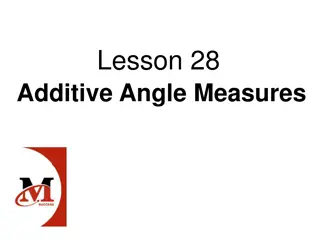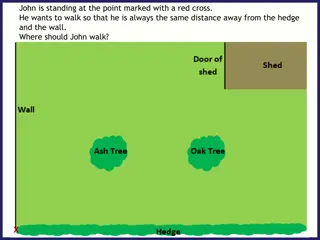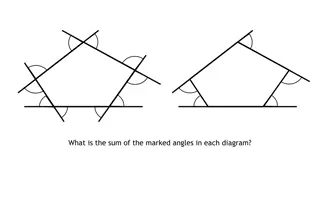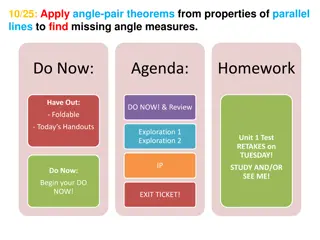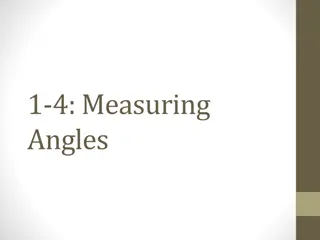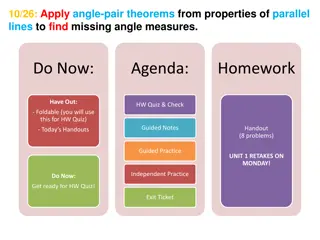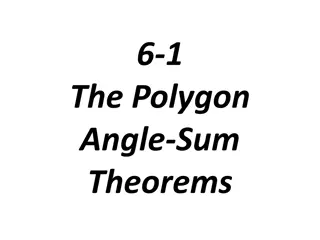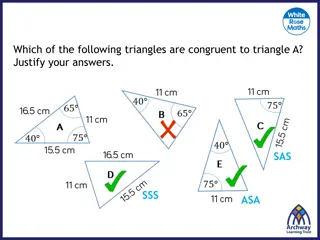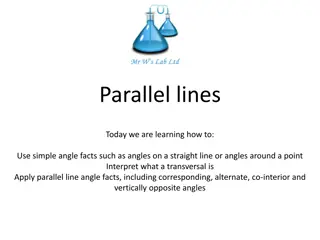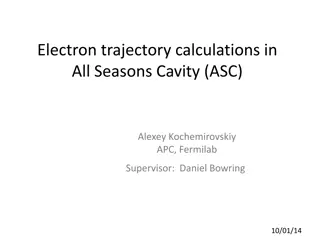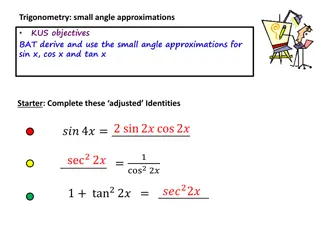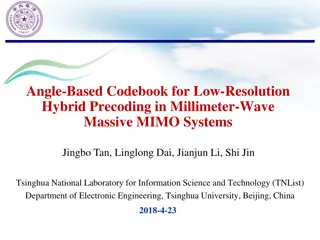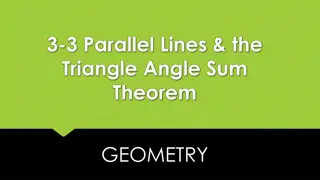AnglE: An Optimization Technique for LLMs by Bishwadeep Sikder
The AnglE model introduces angle optimization to address common challenges like vanishing gradients and underutilization of supervised negatives in Large Language Models (LLMs). By enhancing the gradient and optimization processes, this novel approach improves text embedding learning effectiveness.
12 views • 33 slides
Prism Terminology and Light Deviation
Prisms are optical devices that deviate light without changing its vergence. This module explores the various terminology associated with prisms, including Apex, Base, Refracting Angle, and Angle of Deviation. The passage of light through a prism follows Snell's Law, where the ray is deviated toward
8 views • 42 slides
Angle Relationships in Geometry
Explore key geometry vocabulary such as congruent, vertical, adjacent, complementary, and supplementary angles. Learn how to identify different types of angle pairs and calculate unknown angle measures using angle relationships. Visual examples and explanations enhance understanding.
2 views • 19 slides
Step-by-Step Guide for Using Kruss Goniometer Contact Angle Analyzer
Detailed instructions on how to operate a Kruss goniometer contact angle analyzer. Learn how to set up the equipment, prepare the sample, adjust camera focus, measure contact angle, and analyze the results. Follow each step carefully to achieve accurate measurements.
4 views • 10 slides
Triangle Inequalities and Angle-Side Relationships
Explore the Vocabulary of Exterior Angle Inequality Theorem, Angle-Side Relationship Theorems 5.9 and 5.10. Understand how to order triangel angle measures and side lengths from smallest to largest through examples. Discover the principles governing triangles in terms of angles and side lengths.
3 views • 12 slides
Exterior Angles in Polygons
This content explains the concept of exterior angles in polygons and the Exterior Angle Theorem. It covers how exterior angles are formed when the sides of a polygon are extended, their relationship with interior angles, and how to calculate their measures using the Exterior Angle Theorem. Various e
2 views • 26 slides
Camera Angles in Photography
Photography is a form of art that involves various creative expressions, including the use of different camera angles to capture unique perspectives. This content explores different camera angles such as high-angle shot, low-angle shot, Dutch angle, and straight angle, each offering a distinct visua
6 views • 7 slides
Triangle Congruence Properties
Delve into the principles of congruent triangles by exploring the properties of side-side-side (SSS), side-angle-side (SAS), angle-side-angle (ASA), and right-angle-hypotenuse-side (RHS) congruence. Visual explanations help clarify how these properties determine if triangles are congruent.
0 views • 18 slides
Polar Coordinates in Mathematics
Polar coordinates define the location of a point in terms of distance and angle from an origin. The distance is denoted by "r" and the angle by "?". However, the angle is not unique for a point. The concept involves fixing an origin and an initial ray, with positive angles measured counterclockwise.
3 views • 7 slides
Additive Angle Measures
In this lesson on additive angle measures, students learn how to find missing angle measures when two non-overlapping angles combine to form a larger angle. Essential questions are posed, and students are guided through solving problems involving angle decomposition and measurement. Practical activi
4 views • 46 slides
concepts of equidistance and angle bisector in geometry
Explore the concepts of equidistance and angle bisectors in geometry through practical examples like determining the path for John to walk equidistant from a hedge and a wall, understanding the ideal flight path for a plane to land, constructing angle bisectors, and verifying constructions for accur
3 views • 23 slides
Geometry Angle Sum and Properties Exploration
Dive into the world of geometry with various diagrams and scenarios focusing on angle sums, concave and convex polygons, and angle measurements. Learn about properties of polygons and test your skills in identifying different shapes and their classifications based on their properties. Explore angles
1 views • 18 slides
Angle Pair Theorems in Geometry
Explore the application of angle-pair theorems in finding missing angle measures using properties of parallel lines. Learn about different types of angle pairs such as vertical angles, corresponding angles, same-side interior angles, alternate exterior angles, and more through engaging activities an
1 views • 14 slides
Angles: Definitions, Examples, and Postulates
Explore the world of angles with definitions of angle parts, types of angles, angle pairs, Angle Addition Postulate, and more. Dive into examples and classwork exercises to enhance your understanding of angles in geometry.
4 views • 16 slides
Angle Pair Theorems in Geometry
Learn how to apply angle pair theorems using properties of parallel lines to find missing angle measures. Explore concepts like corresponding angles, alternate interior angles, alternate exterior angles, and consecutive interior angles through visual aids and practice problems.
4 views • 14 slides
Polygon Angle-Sum Theorems
Explore the Polygon Angle-Sum Theorems that determine the sum of interior angle measures in polygons. Learn about the Polygon Angle-Sum Theorem, number of sides in polygons, finding angle sums, and the corollary for regular polygons. Practice using the theorems to calculate interior angle measures i
5 views • 18 slides
Exploring Triangle Similarity and Congruence
This content delves into understanding triangle congruence and similarity through various scenarios and visual representations. It discusses how to determine congruence using side-side-side, side-angle-side, and angle-side-angle criteria, and explores the concept of similarity in triangles based on
1 views • 21 slides
Parallel Lines and Angle Relationships
Learning about parallel lines involves using angle facts like those on a straight line or around a point. By interpreting what a transversal is, you can apply angle relationships such as corresponding, alternate, co-interior, and vertically opposite angles. Practice finding unknown angles and identi
3 views • 20 slides
Glaucoma: Types, Symptoms, and Treatment Options
Glaucoma is a group of eye conditions that can lead to irreversible vision loss. There are different types such as open-angle, closed-angle, secondary, and normal-tension glaucoma, each with unique characteristics and causes. Symptoms vary from rapid damage in closed-angle glaucoma to gradual periph
2 views • 13 slides
Electron Trajectory Calculations in All Seasons Cavity Analysis
This analysis delves into electron trajectory calculations within the All Seasons Cavity (ASC), examining geometry, simulation models, misalignment effects, and the resulting angle distributions. Key findings include the impact of cavity misalignment on angle distributions and the need for further p
1 views • 30 slides
Angle Modulation: Frequency and Phase Variations
Angle modulation involves varying the frequency or phase of a carrier signal based on the modulating signal. Frequency Modulation (FM) and Phase Modulation (PM) are types of angle modulation that offer better noise discrimination. This results in improved robustness against interference but comes at
0 views • 23 slides
Vertically Opposite Angles and Angle Expressions
Delve into the concept of vertically opposite angles and angle expressions through worked examples and practice exercises. Learn to identify, calculate, and express angles in various geometric scenarios, enhancing your understanding of angle relationships.
3 views • 12 slides
Bisectors
Explore the concepts of perpendicular and angle bisectors through the Perpendicular Bisector Theorem, Converse of the Perpendicular Bisector Theorem, Angle Bisector Theorem, and Converse of the Angle Bisector Theorem. Learn how these theorems are applied in geometry with illustrative examples. Get i
2 views • 7 slides
Trigonometry Small Angle Approximations and Identities
Delve into the use of small angle approximations in trigonometry, deriving and applying identities for sine, cosine, and tangent functions. Understand the significance of small angles in accurate calculations and explore the practical applications in physics fields. Discover adjusted trigonometric i
3 views • 13 slides
Angle Pairs and Relationships Exploration
This lesson delves into identifying special angle pairs and utilizing their relationships to determine angle measures. Students will learn about adjacent angles, linear pairs, vertical angles, complementary angles, and supplementary angles through engaging activities and sample problems.
5 views • 29 slides
Congruent Triangles
In geometry, congruent triangles have equal sides and angles, leading to unique properties and relationships. By exploring the concepts of congruence in triangles, such as SSS (side-side-side), SAS (side-angle-side), ASA (angle-side-angle), and RHS (right-angle-hypotenuse-side), students develop a d
1 views • 20 slides
Triangle Angle-Sum Theorem & Exterior Angles
The classification of triangles based on angles and sides, discover the Triangle Angle-Sum Theorem where the sum of angles in a triangle is 180 degrees, and understand the concept of exterior angles in triangles. Learn how to find missing angle values and classify triangles by angles and sides using
8 views • 10 slides
Angle-Based Codebook for Low-Resolution Hybrid Precoding in Millimeter-Wave Massive MIMO Systems
This study explores the use of angle-based codebook for low-resolution hybrid precoding in millimeter-wave massive MIMO systems, aiming to optimize performance while reducing energy consumption. The research delves into the technical background, angle-based codebook design, performance analysis, sim
1 views • 21 slides
Critical Angle in Electromagnetic Wave Propagation
Explore the concept of critical angle in electromagnetic waves, how it applies to different materials, and what happens beyond the critical angle in wave propagation scenarios. Learn about the polarization considerations and power flow dynamics associated with critical angle phenomena.
1 views • 17 slides
Projectile Motion: Finding Range, Maximum Range, and Optimal Angle
Learn how to calculate the range of a projectile in terms of initial speed and launch angle, determine the maximum range achievable, and identify the optimal launch angle for maximum range using trigonometry in projectile motion problems.
5 views • 4 slides
Geometry Concepts and Angle Calculations
Explore various geometry concepts such as sum of marked angles, concave and convex polygons, and angle calculations in different shapes like hexagons and triangles. Test your angle-solving skills with interactive exercises provided in the content.
2 views • 18 slides
Polygon Angle-Sum Theorems and Problems
Explore the Polygon Angle-Sum Theorems, find the sum of interior angle measures for different polygons, and solve related problems. Understand properties of regular polygons and how to calculate interior angle measures using the Polygon Angle-Sum Theorem.
20 views • 18 slides
Geometry Concepts: Parallel Lines, Triangle Angle-Sum Theorem, Classifying Triangles
Explore key geometry concepts including parallel lines, the triangle angle-sum theorem, triangle classification by angles and sides. Understand the relationships between angles and sides in triangles through practical examples and the exterior angle theorem.
0 views • 10 slides
Triangle Congruence Theorems and Proofs
Explore the triangle congruence theorems ASA, AAS, and AAS postulates, along with angle-angle-side and side-angle-side rules. Learn how to identify congruent triangles and write two-column proofs. Dive into geometry concepts with visual aids.
0 views • 8 slides
Proving Triangles Similar: AA, SAS, SSS
Explore the concepts of Angle-Angle, Side-Angle-Side, and Side-Side-Side similarity postulates to prove triangles are similar. Understand how to apply these statements with examples and find lengths in similar triangles.
0 views • 8 slides
Materials Science - Torsional Stress and Angle of Twist
Explore the concept of torsional stress and angle of twist in strength of materials. Learn about torsion, torsional shearing stress, and how different factors affect the behavior of materials under torsional loads. Gain insights into calculating torsional shearing stress, angle of twist, and the sig
1 views • 6 slides
Understanding Radian Angle in Rotational Motion
Learn about the concept of radian angle in rotational motion, relating it to linear speed and angular frequency. Explore how different points on a rotating body maintain constant angular relationships despite varying radii. Discover the significance of the constant quantity representing the angle in
0 views • 19 slides
Geometry Angles: Interior and Exterior Polygon Angle Sums
Explore the properties of interior and exterior angles in polygons, including finding the sum of interior angles for various shapes, determining the number of sides in a polygon given the sum of angles, and making conjectures on angle sums without measuring. Delve into the relationship between the n
1 views • 23 slides
Angles Facts and Missing Angle Challenges
Explore various angle facts and challenges where you identify missing angles on straight lines. Test your knowledge and skills with different angle combinations, calculations, and expressions provided in the content.
0 views • 12 slides
Geometry Practice Questions
Practice geometry questions involving angle bisectors, acute angles, angle classification, and sketching different types of angles. Explore how to find angle measurements, determine possible values, and sketch various angle examples. Improve your geometry skills with these questions.
2 views • 9 slides

